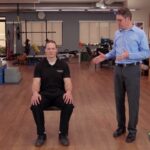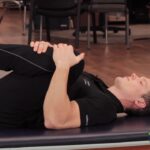Seated Hip Rotator Stretch – Early Intervention Ergonomics
What is the Seated Hip Rotator Stretch?
The seated hip rotator stretch is a highly effective stretching exercise that can help increase flexibility and mobility in your hip joints. To perform this stretch, start by sitting on a sturdy chair. Cross your right leg over your left, placing your ankle on your left knee. Grab the right knee with both hands and pull it gently towards your left shoulder. Hold for 3-5 seconds and repeat on the opposite side. Perform this stretch to give your body a rest when performing activities that involve lifting, carrying, foot pedal use, prolonged standing, prolonged sitting or prolonged walking. This stretch is particularly useful for individuals who spend extended periods of time sitting, as it can help alleviate stiffness and tension in the hips.
Early Intervention Benefits of this Stretch
The seated hip rotator stretch is an excellent early intervention exercise that can help strengthen the hip muscles thus improving stability and preventing injuries in the hips, knees, and ankles. Strong hip muscles can also reduce knee pain and lower back pain. Stretches can help to improve hip flexibility and range of motion.
In addition to the benefits mentioned above, studies have found that greater hip external rotator strength allows better dynamic control and hip function upon landing.
Insufficient hip internal rotation can lead to gait issues. When other parts of the lower body compensate for insufficient hip internal rotation, it might increase your risk of an injury. Some hip internal rotation exercises and stretches can put pressure on your knees. If you feel pain in your knee at any time, you should stop immediately.
If you have an injury or illness, consult with a health care professional before attempting.
These early intervention exercises are to improve overall health and fitness.
More Tools & Resources from Peak Ergonomics
Contact Us About Reducing Workplace Injuries
Healthy Employees are the Bottom Line! – Learn More!


